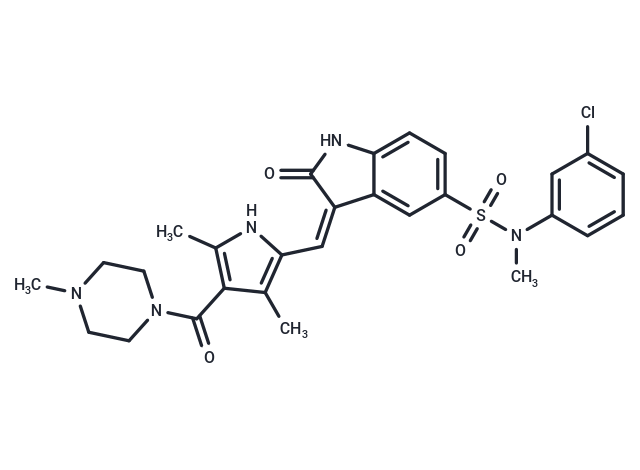Shopping Cart
- Remove All

Your shopping cart is currently empty


| Pack Size | Price | Availability | Quantity |
|---|---|---|---|
| 1 mg | $39 | In Stock | |
| 2 mg | $54 | In Stock | |
| 5 mg | $98 | In Stock | |
| 10 mg | $153 | In Stock | |
| 25 mg | $297 | In Stock | |
| 50 mg | $490 | In Stock | |
| 100 mg | $725 | In Stock | |
| 1 mL x 10 mM (in DMSO) | $153 | In Stock |
| Description | SU11274 (Met Kinase Inhibitor)(IC50=10 nM) is a specific Met inhibitor. It shows no significant effects on PGDFRβ, EGFR or Tie2. |
| In vivo | SU11274 inhibits the phosphorylation of key regulators in the PI3K pathway, including AKT, FKHR, and GSK3β. It also inhibits the HGF-dependent phosphorylation of Met and the subsequent HGF-dependent cellular proliferation and activity, with an IC50 ranging from 1 to 1.5 μM. In BaF3 cells transformed by TPR-MET, the presence of interleukin-3 and treatment with SU11274 suppress cell growth in a dose-dependent manner. However, SU11274 (IC50 <3 μM) does not inhibit the growth of BaF3 cells transformed by other oncogenic tyrosine kinases, including BCR-ABL, TEL-JAK2, TEL-ABL, and TEL-PDGFβR. Treatment with SU11274 also significantly inhibits cell migration in BaF3.TPR-MET cells with inhibitions of 44.8% and 80% at concentrations of 1 μM and 5 μM, respectively. In H69 and H345 cells, which possess functional Met receptors, SU11274 inhibits HGF-induced cell growth with IC50 values of 3.4 μM and 6.5 μM, respectively. In non-small cell lung cancer (NSCLC) cells expressing c-Met, SU11274 inhibits cell viability with an IC50 of 0.8-4.4 μM and abrogates the phosphorylation of c-Met and its downstream signaling induced by hepatocyte growth factor. |
| Kinase Assay | In vitro Met kinase assay: A chimeric protein is constructed containing the cytoplasmic domain of human c-Met fused to Glutathione S-transferase (GST) and expressed in SF9 cells. The c-Met kinase GST-fusion protein is used for an ELISA-based Met biochemical assay using the random copolymer poly(Glu:Tyr) (4:1) immobilized on microtiter plates as a substrate. IC50 value is determined with various concentrations of SU11274 in a buffer containing 5 μM ATP and 10 mM MnCl2, 50 mM HEPES (pH 7.5), 25 mM NaCl, 0.01% BSA, and 0.1 mM Na orthovanadate. The kinase reaction is performed for 5 minutes at room temperature. The extent of substrate phosphorylation is measured using horseradish peroxidase-conjugated anti-pTyr antibodies. |
| Cell Research | Cells are exposed to various concentrations of SU11274 in the presence or absence of HGF for 24, 48, and 72 hours. The number of viable cells is determined using the MTT assay or trypan blue exclusion. Cell Cycle and apoptosis are measured by fluorescence-activated cell sorter analysis via propidium iodide staining and Annexin V-positive staining, respectively. (Only for Reference) |
| Alias | Met Kinase Inhibitor, PKI-SU11274 |
| Molecular Weight | 568.09 |
| Formula | C28H30ClN5O4S |
| Cas No. | 658084-23-2 |
| Storage | Powder: -20°C for 3 years | In solvent: -80°C for 1 year | ||||||||||||||||||||||||||||||||||||||||
| Solubility Information | H2O: < 1 mg/mL (insoluble or slightly soluble) Ethanol: 2 mg/mL (3.52 mM) DMSO: 85 mg/mL (149.6 mM) | ||||||||||||||||||||||||||||||||||||||||
Solution Preparation Table | |||||||||||||||||||||||||||||||||||||||||
Ethanol/DMSO
DMSO
| |||||||||||||||||||||||||||||||||||||||||

Copyright © 2015-2024 TargetMol Chemicals Inc. All Rights Reserved.